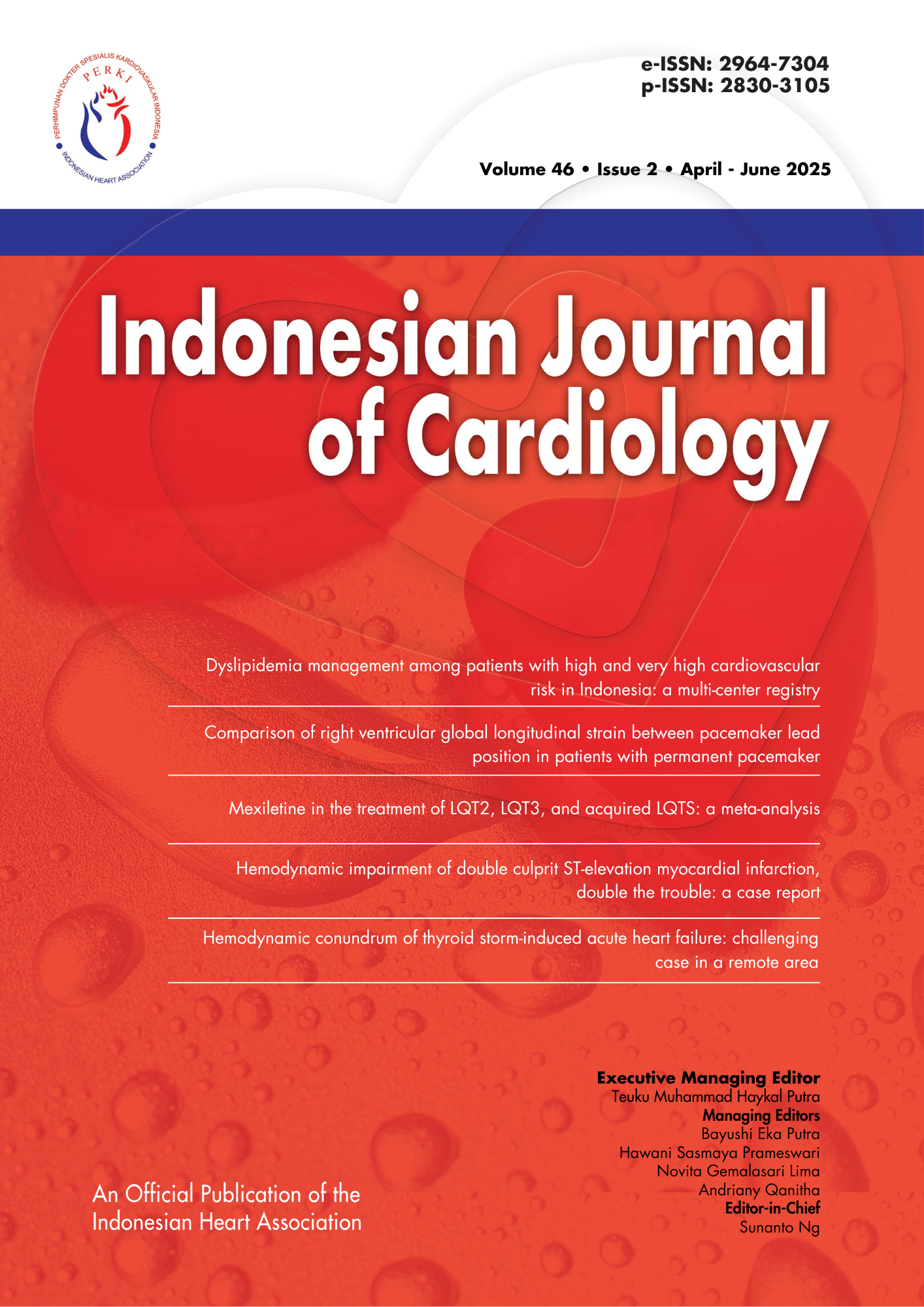Hemodynamic impairment of double culprit ST-elevation myocardial infarction, double the trouble: a case report
Abstract
Background: Multiple culprit artery involvement is rare (2.5%) among ST-segment elevation myocardial infarction (STEMI) patients undergoing primary coronary intervention (PCI). It can occur due to multiple factors and reflects a widespread pathophysiologic process. Most patients present with unstable hemodynamics and cardiogenic shock (CS), which results in a high mortality rate. Currently, there are no guidelines or consensuses on the management of multiple culprit arteries in STEMI patients.
Case Illustration: A 51-year-old man with chest pain in the past 16 hours was referred to the National Cardiovascular Center Harapan Kita. ECG at presentation revealed sinus rhythm with ST elevation in the inferior, posterior, and right leads. He was diagnosed with late-onset infero-posterior STEMI + right ventricle infarction, Killip IV, and thrombolysis in myocardial infarction 6/14, then was prepared for early PCI due to ongoing chest pain and CS. The patient underwent complete revascularization with drug-eluting stents and thrombus aspiration due to the high thrombus burden of the lesion in the right coronary artery and first obtuse marginal artery. After early PCI, his hemodynamic condition improved, and epigastric pain was his only complaint. However, on the following day, the patient experienced acute pulmonary edema and rhythm conversion to total AV block. He was managed conservatively with heparinization, inotropes, vasopressors, diuretics, and noninvasive ventilation. After 14 days of hospitalization, the patient was discharged without any complaints.
Conclusion: Double culprit STEMI is rare and associated with catastrophic hemodynamic impairment, including CS, at presentation. Individualized treatment with early and aggressive revascularization yields relatively good results.
Downloads
References
2. Mahmoud A, Saad M, Elgendy IY. Simultaneous multi-vessel coronary thrombosis in patients with ST-elevation myocardial infarction: a systematic review. Cardiovasc Revascularization Med Mol Interv. 2015;16(3):163–6.
3. Hage G, Reibel I, Dib JC, Beverelli F, Allouch P, Makowski S, et al. Double Culprit Lesions in a Patient With ST-Segment Elevation Myocardial Infarction. JACC Case Rep. 2021 Dec 15;3(18):1906–10.
4. Kim S, Seol S, Park D, Song Y, Kim D, Kim K, et al. Simultaneous multiple coronary arteries thrombosis in patients with STEMI. J Geriatr Cardiol JGC. 2018 Mar;15(3):241–3.
5. Collet JP, Thiele H, Barbato E, Barthélémy O, Bauersachs J, Bhatt DL, et al. 2020 ESC Guidelines for the management of acute coronary syndromes in patients presenting without persistent ST-segment elevation. Eur Heart J. 2021 Apr 7;42(14):1289–367.
6. Mehta SR, Wood DA, Storey RF, Mehran R, Bainey KR, Nguyen H, et al. Complete Revascularization with Multivessel PCI for Myocardial Infarction. N Engl J Med. 2019 Oct 10;381(15):1411–21.
7. Hochman JS, Sleeper LA, Webb JG, Sanborn TA, White HD, Talley JD, et al. Early Revascularization in Acute Myocardial Infarction Complicated by Cardiogenic Shock. N Engl J Med. 1999 Aug 26;341(9):625–34.
8. Thiele Holger, Akin Ibrahim, Sandri Marcus, Fuernau Georg, de Waha Suzanne, Meyer-Saraei Roza, et al. PCI Strategies in Patients with Acute Myocardial Infarction and Cardiogenic Shock. N Engl J Med. 2017;377(25):2419–32.
9. Hage G, Reibel I, Dib JC, Beverelli F, Allouch P. Double Culprit Lesions in a Patient With ST-Segment Elevation Myocardial Infarction. JACC Case Rep. 2021;3(18):1906–10.
10. Turgeman Y, Suleiman K, Atar S. Multivessel Acute Coronary Thrombosis and Occlusion ‚ An Unusual Cause of Cardiogenic Shock. J Invasive Cardiol. 2008 Aug 1;19(9).
11. Caliskan R, Ince H, Arslan F. Multiple culprit lesions in ST-segment elevation myocardial infarction with cardiogenic shock: a case of simultaneous thrombosis of two infarct-related arteries. Neth Heart J. 2022 Jun;30(6):338–9.
12. Saito R, Koyama K, Kongoji K, Soejima K. Acute myocardial infarction with simultaneous total occlusion of the left anterior descending artery and right coronary artery successfully treated with percutaneous coronary intervention. BMC Cardiovasc Disord. 2022;1–9.
13. Nordkin I, Goldberg A, Israeli Z, Halabi M. Complicated acute myocardial infarction with simultaneous occlusion of two coronary arteries. Clin Case Rep. 2020 Jan 30;8(3):449–52.
14. Ginanjar E, Yulianto Y, Salim S, Setyawan W. Double Culprits in a Patient with ST Elevation Myocardial Infarction: A Challenging But Rewarding Case. Acta Medica Indones. 2018 Apr;50(2):165–7.
15. Byrne RA, Rossello X, Coughlan JJ, Barbato E, Berry C, Chieffo A, et al. 2023 ESC Guidelines for the management of acute coronary syndromes. Eur Heart J. 2023 Oct 12;44(38):3720–826.
16. Jolly SS, Cairns JA, Yusuf S, Meeks B, Pogue J, Rokoss MJ, et al. Randomized Trial of Primary PCI with or without Routine Manual Thrombectomy. N Engl J Med. 2015;372(15):1389–98.
17. Kusumoto FM, Schoenfeld MH, Barrett C, Edgerton JR, Ellenbogen KA, Gold MR, et al. 2018 ACC/AHA/HRS Guideline on the Evaluation and Management of Patients With Bradycardia and Cardiac Conduction Delay: Executive Summary: A Report of the American College of Cardiology/American Heart Association Task Force on Clinical Practice Guidelines, and the Heart Rhythm Society. J Am Coll Cardiol. 2019 Aug 20;74(7):932–87.
18. Thiele H, Zeymer U, Neumann FJ, Ferenc M, Olbrich HG, Hausleiter J, et al. Intraaortic Balloon Support for Myocardial Infarction with Cardiogenic Shock. N Engl J Med. 2012;367(14):1287–96.
PDF downloads: 51
Copyright (c) 2025 Indonesian Journal of Cardiology

This work is licensed under a Creative Commons Attribution 4.0 International License.
Authors who publish with this journal agree to the following terms:
- Authors retain copyright and grant the journal right of first publication with the work simultaneously licensed under a Creative Commons Attribution License that allows others to share the work with an acknowledgement of the work's authorship and initial publication in this journal.
- Authors are able to enter into separate, additional contractual arrangements for the non-exclusive distribution of the journal's published version of the work (e.g., post it to an institutional repository or publish it in a book), with an acknowledgement of its initial publication in this journal.
- Authors are permitted and encouraged to post their work online (e.g., in institutional repositories or on their website) prior to and during the submission process, as it can lead to productive exchanges, as well as earlier and greater citation of published work (See The Effect of Open Access).



















